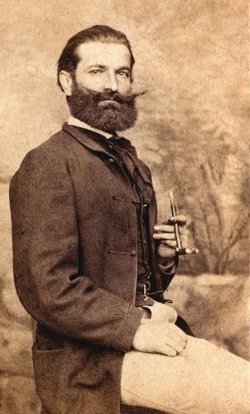Ferenc Veress
 | |
| Born |
September 1, 1832 Cluj, Grand Principality of Transylvania, Austrian Empire |
|---|---|
| Died |
April 3, 1916 (aged 83) Cluj, Romania |
Ferenc Veress (1832–1916) was a photographer and inventor. He got from his first camera from his mother in 1850. Two years later he opened a photographic studio in Cluj. Following contacts with Transylvanian nobles as Miklós Zeyk, Károly Apor and Zsigmond Kornis, Veress is familiar from early youth with Daguerre 's and Talbot's photographic processes. His cabinet is the first photographic studio here and in all of Transylvania. He was specialising in portraits, but also photographed the street life and landscape. All through his long career (which lasted more than 60 years), Veress successfully promote in Cluj the latest discoveries in Europe in the field of art and photography: daghereotipia, wet plate process, coated with collodion, and the dried silver bromide. In 1855, following the advices of Miko Imre, Ferenc Veress performed a first set of photos depicting important people of Transylvania, especially members of aristocratic families from Cluj. In 1859, Veress made two albums, entitled 'képekben Kolozsvár' [Images of Cluj] containing 45 images of the most iconic photographs of areas and buildings of Cluj. The two albums are stored at the Central University Library "Lucian Blaga" of Cluj . In 1867, Ferenc Veress take a trip to Paris, where he get to know Niepce de Saint-Victor, who instilled interest in color photography called then heliochromie. Between 1882-1888, Veress will prepare and publish, in Cluj, a specialized magazine entitled 'Fényképészeti Lapok' [Sheets Photo]. In this magazine, Veress presented the latest developments in its field, complementing information with those acquired abroad on his own experiences.
- Gallery
- See also
- External links














